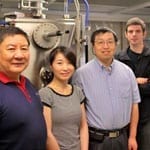 Using nanoscale materials, researchers at the University of Georgia (UGA) have developed a single-step method to rapidly and accurately detect viruses, bacteria and chemical contaminants.
Using nanoscale materials, researchers at the University of Georgia (UGA) have developed a single-step method to rapidly and accurately detect viruses, bacteria and chemical contaminants.
“The results are unambiguous and quickly give you a high degree of specificity,” said Yiping Zhao, Professor of Physics in the UGA Franklin College of Arts and Sciences and Director of the University’s Nanoscale Science and Engineering Center.
The team utilized an instrument designed by the UGA Instrument Shop to deposit silver nanorods 1,000 times finer than the width of a human hair on a chip that can be used to detect viruses, bacteria and chemical contaminants. They combined this capability with two well-known techniques, Ramen spectroscopy (SERS) and Thin Layer Chromatography (TLC), to create their new testing method.
Every compound displays a series of distinctive changes in frequency, or Raman shifts, that are as unique as a fingerprint. The signal produced by Raman scattering is inherently weak, but arraying the silver nanorods at a precise angle significantly amplifies the signal.
“In a clinical setting, the sample that you obtain from patients typically contains bacteria or viruses as well as a lot of fluid—as in blood, urine or saliva—that contains biological agents that interfere with the signal you’re trying to detect,” Zhao said. “To develop a diagnostic that could be used at the point of care, we needed a way to separate those agents.”
Once again, the scientists turned to nanotechnology to create a next-generation diagnostic test. Using traditional thin layer chromatography, or TLC, scientists blot a drop of sample onto a porous surface. They then apply a solvent such as methanol to the sample, and the sample components separate based on how strongly they’re attracted to the solvent and the surface.
Justin Abell, a doctoral student in the UGA College of Engineering, explained that TLC typically requires a large sample volume because the compound of interest soaks into the surface in addition to moving along it, like a stain on a rug. The silver nanorod surface that the researchers use, in contrast, allows them to use a miniscule amount of sample in a technique known as ultra-thin layer chromatography.
“In our case, the nanorods are acting as the detection medium but also as the separation medium,” Abell said, “so it’s a two-in-one system.”
In a series of studies, the scientists were able to detect compounds such as lactic acid and the protein albumin in highly diluted samples and in mixtures that included dyes and other chemicals, even in samples diluted to concentrations below 182 nanograms per milliliter. Their results suggest that the same system could be used to detect pathogens and contaminants in biological mixtures such as food, blood, saliva and urine.
Zhao said that while his team is focused on health and food safety applications, SERS and ultra-thin layer chromatography can be used to detect compounds of all types—everything from forensic materials at a crime scene to environmental pollutants. His team also is working with colleagues across campus to create an online encyclopedia that would allow technicians to identify viruses, bacteria, biomarkers and pharmaceuticals based on their distinctive Raman shifts.
“Every compound has a unique SERS spectrum,” Zhao said, “so this is a very robust technology whose applications are practically endless.”
Image: UGA researchers Yao-Wen Huang, Jing Chen, Yiping Zhao and Justin Abell stand in front of an electron beam evaporator at the UGA Nanoscale Science and Engineering Center. (Courtesy of Sam Fahm, UGA)


